Historical Memory as an Effective and Useful Tool for Proper Land Use Planning: Lessons Learnt from Some Italian Cases
Abstract
:1. Introduction
2. Pioneers in the Use of Historical Sources to Study Natural Hazards in Italy: An Overview
2.1. Floods and Landslides
2.2. Earthquakes
2.3. Volcanoes
3. Materials and Methods
3.1. General Settings of the Case Studies
3.2. Methods
4. Results
4.1. Belbo Stream and Its Floods in Canelli Town (Northwestern Italy)


4.2. Forced Abandonment of Craco (Basilicata, Southern Italy)
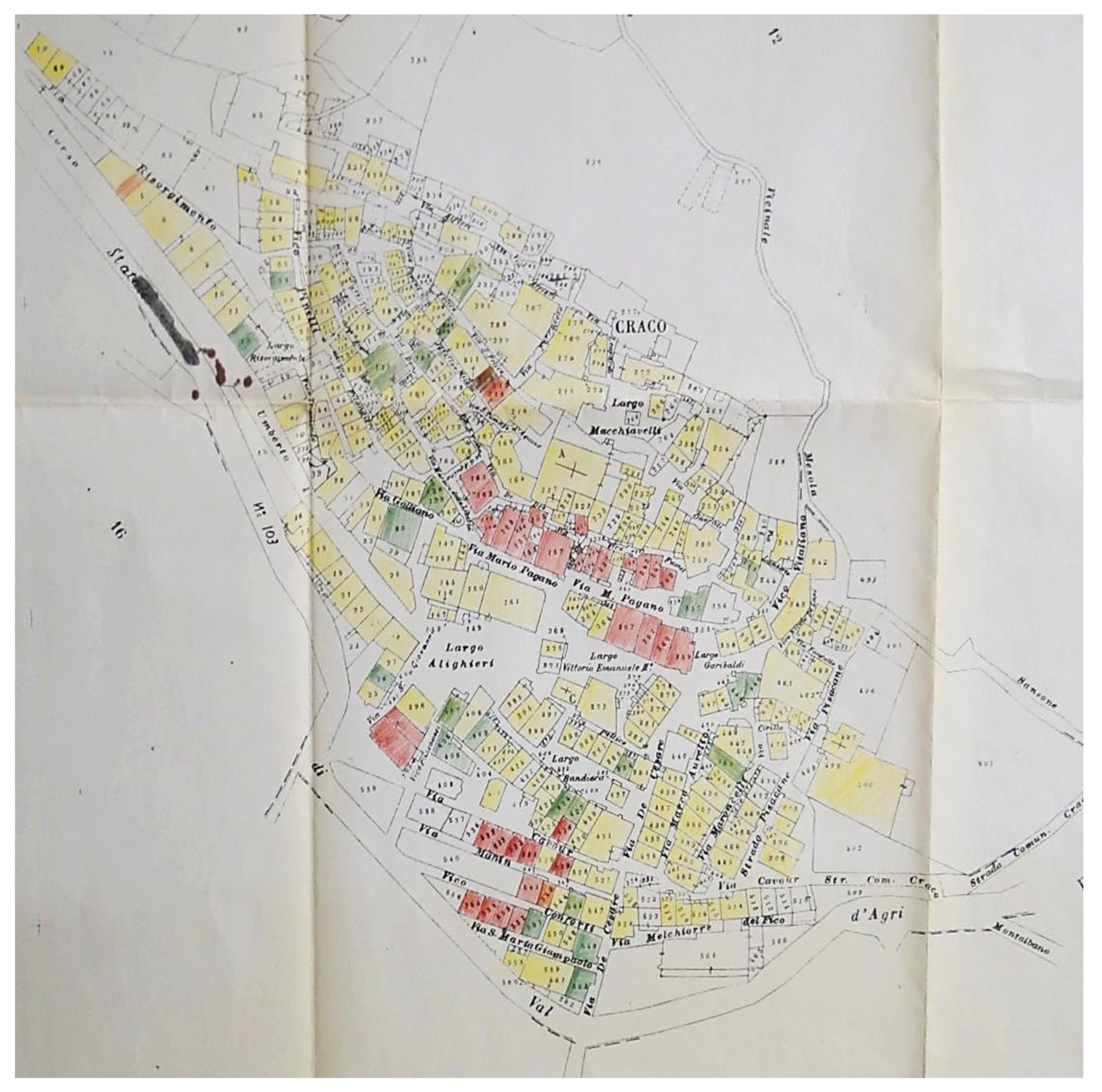

4.3. Gragnano Debris Flows (Naples District)
4.4. The Memory of Earthquake-Induced Instability in Calitri
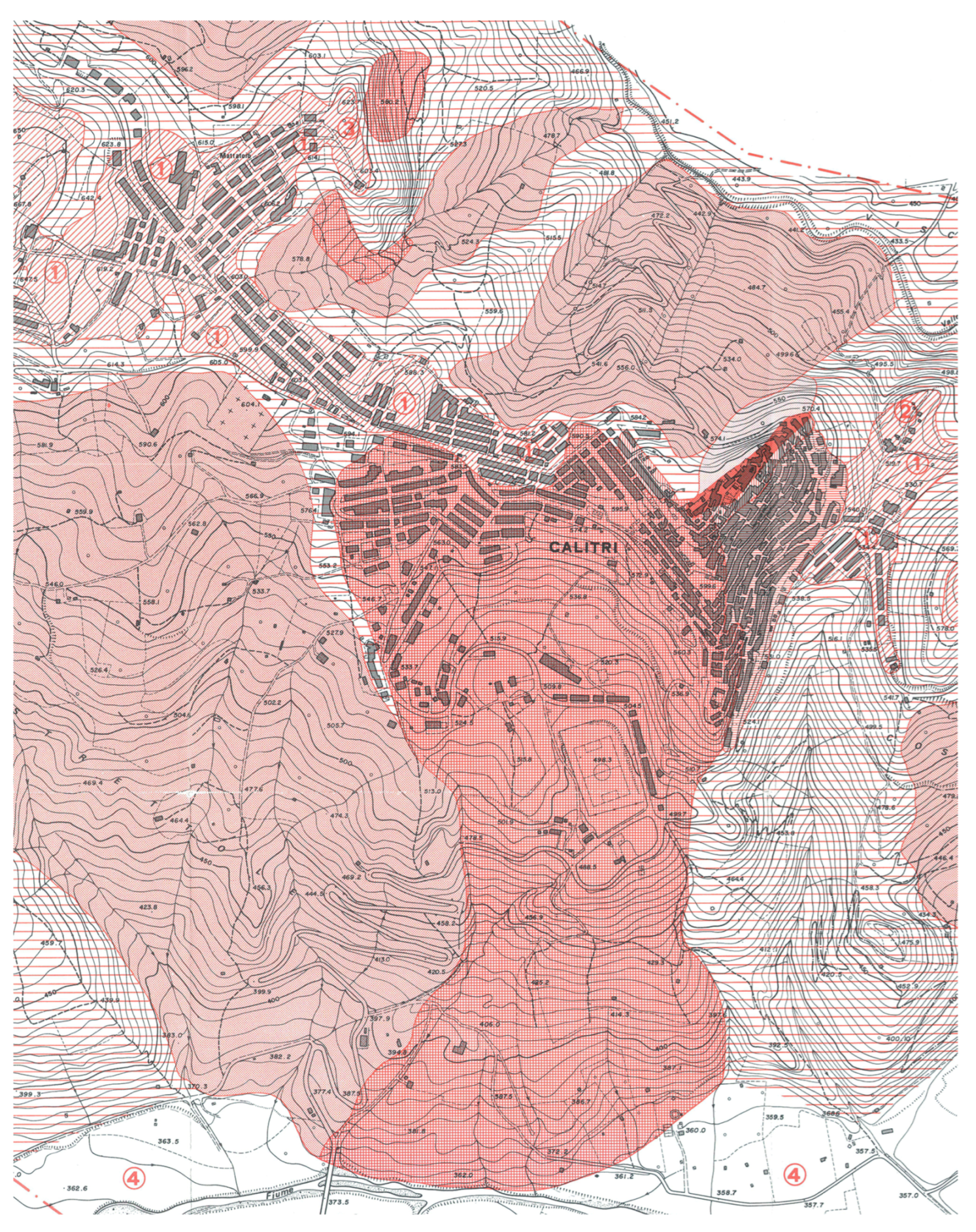
4.5. Debris Flows on Supita Alluvial Fan (Venaus—Turin)
5. Discussion
6. Conclusions and Perspectives
Author Contributions
Funding
Data Availability Statement
Conflicts of Interest
Abbreviation
References
- Desio, A. Geologia dell’Italia, 1st ed.; UTET: Torino, Italy, 1973; p. 1081. (In Italian) [Google Scholar]
- Dal Piaz, G.V.; Bistacchi, A.; Massironi, M. Geological outline of the Alps. Episodes 2003, 26, 175–181. [Google Scholar] [CrossRef]
- Pasquarè, G.; Venturini, C. Mapping Geology in Italy, 1st ed.; Selca: Firenze, Italy, 2004; p. 330. ISBN 88 448 0189 2. [Google Scholar]
- Marchetti, M.; Soldati, M.; Vandelli, V. The Great Diversity of Italian Landscapes and Landforms: Their Origin and Human Imprint. In Landscapes and Landforms of Italy. World Geomorphological Landscapes, 1st ed.; Soldati, M., Marchetti, M., Eds.; Springer: Cham, Switzerland, 2017. [Google Scholar] [CrossRef]
- Rovida, A.; Locati, M.; Camassi, R.; Lolli, B.; Gasperini, P.; Antonucci, A. Catalogo Parametrico dei Terremoti Italiani (CPTI15), 4th ed.; Istituto Nazionale di Geofisica e Vulcanologia (INGV): Bologna, Italy, 2022.
- Baratta, M. La Catastrofe Sismica Calabro-Messinese. 28 Dicembre 1908; Società Geografica Italiana: Roma, Italy, 1910; Volume 2, p. 426. (In Italian) [Google Scholar]
- Caciagli, M. Le Tracce del Terremoto del 1908 Nell’ambiente Naturale. In Il Terremoto e il Maremoto del 28 Dicembre 1908: Analisi Sismologica, Impatto, Prospettive, 1st ed.; Bertolaso, G., Boschi, E., Guidoboni, E., Valensise, G., Eds.; INGV-DPC: Roma, Bologna, Italy, 2008; pp. 197–214. (In Italian) [Google Scholar]
- Porfido, S.; Esposito, E.; Violante, C.; Molisso, F.; Sacchi, M.; Spiga, E. Earthquakes-Induced Environmental Effects in Coastal Area: Some Example in Calabria and Sicily (Southern Italy), 1st ed.; Marine Research at CNR Dta: Venezia, Italy, 2011; Volume DTA/06-2011, ISSN 2239-5172. [Google Scholar]
- Barbano, M.S.; Castelli, V.; Pantosti, D.; Pirrotta, C. Integration of historical, archaeoseismic and paleo-seismological data for the reconstruction of the early seismic history in Messina Strait (south Italy): The 1st and 4th centuries AD earthquakes. Ann. Geophys. 2014, 57, S0192. [Google Scholar] [CrossRef]
- Comerci, V.; Vittori, E.; Blumetti, A.M.; Brustia, E.; Di Manna, P.; Guerrieri, L.; Lucarini, M.; Serva, L. Environmental effects of the December 28, 1908, Southern Calabria–Messina (Southern Italy) earthquake. Nat. Hazards 2015, 76, 1849–1891. [Google Scholar] [CrossRef]
- Procházková, D.; Schenková, Z.; Kárník, V. Macroseismic fields of the main Friuli shocks of 1976. Tectonophysics 1979, 53, 249–259. [Google Scholar] [CrossRef]
- Slejko, D.; Neri, G.; Orozova, I.; Renner, G.; Wyss, M. Stress field in Friuli (NE Italy) from fault plane solutions of activity following the 1976 mainshock. Bull. Seism. Soc. Am. 1999, 89, 1037–1052. [Google Scholar] [CrossRef]
- Postpischl, D.; Branno, A.; Esposito, E.; Ferrari, G.; Marturano, A.; Porfido, S.; Rinaldis, V.; Stucchi, M. The Irpinia earthquake of November 23, 1980. In Atlas of Isoseismal Maps of Italian Earthquakes, 1st ed.; Postpischl, D., Ed.; Quaderni della Ricerca Scientifica: Roma, Italy, 1985; Volume 114, pp. 152–157. [Google Scholar]
- Gizzi, F.T.; Potenza, M.R.; Zotta, C. 23 November 1980 Irpinia-Basilicata earthquake (Southern Italy): Towards a full knowledge of the seismic effects. Bull. Earthq. Eng. 2012, 10, 1109–1131. [Google Scholar] [CrossRef]
- Gizzi, F.T.; Potenza, M.R. The Scientific Landscape of November 23rd, 1980 Irpinia-Basilicata Earthquake: Taking Stock of (Almost) 40 Years of Studies. Geosciences 2020, 10, 482. [Google Scholar] [CrossRef]
- Porfido, S.; Alessio, G.; Gaudiosi, G.; Nappi, R.; Michetti, A.M. 40 Years Later: New Perspectives on the 23 November 1980, Ms 6.9, Irpinia-Lucania Earthquake. Geosciences 2022, 12, 173. [Google Scholar] [CrossRef]
- Galli, P.; Camassi, R.; Azzaro, R.; Bernardini, F.; Castenetto, S.; Molin, D.; Tertulliani, A. Il terremoto aquilano del 6 aprile 2009: Rilievo macrosismico, effetti di superficie ed implicazioni sismotettoniche. Quaternario 2009, 22, 235–246. (In Italian) [Google Scholar]
- Vittori, E.; Di Manna, P.; Blumetti, A.M.; Comerci, V.; Guerrieri, L.; Esposito, E.; Michetti, A.M.; Porfido, S.; Piccardi, L.; Roberts, G.P.; et al. Surface Faulting of the 6 April 2009 Mw 6.3 L’Aquila Earthquake in Central Italy. Bull. Seismol. Soc. Am. 2011, 101, 1507–1530. [Google Scholar] [CrossRef]
- Galli, P.; Peronace, E.; Bramerini, F.; Castenetto, S.; Naso, G.; Cassone, F.; Pallone, F. The MCS intensity distribution of the devastating 24 August 2016 earthquake in central Italy (Mw 6.2). Ann. Geophys. 2016, 59, 13. [Google Scholar] [CrossRef]
- Galli, P.; Castenetto, S.; Peronace, E. The macroseismic intensity distribution of the October 30, 2016 earthquake in central Italy (Mw 6.6). Seismotectonic implications. Tectonics 2017, 36, 2179–2197. [Google Scholar] [CrossRef]
- Rossi, A.; Tertulliani, A.; Azzaro, R.; Graziani, L.; Rovida, A.; Maramai, A.; Pessina, V.; Hailemikael, S.; Buffarini, G.; Bernardini, F.; et al. The 2016–2017 earthquake sequence in central Italy: Macroseismic survey and damage scenario through the EMS-98 intensity assessment. Bull. Earthq. Eng. 2019, 17, 2407–2431. [Google Scholar] [CrossRef]
- Gizzi, F.T.; Kam, J.; Porrini, D. Time windows of opportunities to fight earthquake under-insurance: Evidence from Google Trends. Humanit. Soc. Sci. Commun. 2020, 7, 61. [Google Scholar] [CrossRef]
- Morgan, D.J.; Blake, S.; Rogers, N.W.; DeVivo, B.; Rolandi, G.; Macdonald, R.; Hawkesworth, C.J. Time scales of crystal residence and magma chamber volume from modelling of diffusion profiles in phenocrysts: Vesuvius 1944. Earth Planet. Sci. Lett. 2004, 222, 933–946. [Google Scholar] [CrossRef]
- Branca, S.; De Beni, E.; Proietti, C. The large and destructive 1669 AD eruption at Etna volcano: Re-construction of the lava flow field evolution and effusion rate trend. Bull. Volcanol. 2013, 75, 694. [Google Scholar] [CrossRef]
- Sanderson, T. Direct gravimetric detection of magma movements at Mount Etna. Nature 1982, 297, 487–490. [Google Scholar] [CrossRef]
- Branca, S.; Del Carlo, P. Eruptions of Mt Etna During the Past 3,200 Years: A Revised Compilation Integrating the Historical and Stratigraphic Records. In Mt. Etna: Volcano Laboratory; Bonaccorso, A., Calvari, S., Coltelli, M., Del Negro, C., Falsaperla, S., Eds.; AGU: Washington, DC, USA, 2004; Volume 143, pp. 1–27. [Google Scholar]
- Canuti, P.; Casagli, N.; Pellegrini, M.; Tosatti, G. Geo-Hydrological Hazards. Anatomy of an Orogen: The Apennines and Adjacent Mediterranean Basins; Kluwer Academic Publishers: Alphen aan den Rijn, The Netherlands, 2001; pp. 513–532. [Google Scholar]
- ISPRA Rapporto Sulle Condizioni di Pericolosità da Alluvione in Italia e Indicatori di Rischio Associati. In ISPRA Rep.; 2021; 353, p. 184. Available online: https://www.isprambiente.gov.it/files2021/pubblicazioni/rapporti/rapporto_alluvioni_ispra_353_16_11_2021_rev2.pdf (accessed on 4 December 2022). (In Italian)
- Semenza, E.; Ghirotti, M. History of the 1963 Vaiont slide: The importance of geological factors. Bull. Eng. Geol. Env. 2000, 59, 87–97. [Google Scholar] [CrossRef]
- Kilburn, C.R.J.; Petley, D.N. Forecasting giant, catastrophic slope collapse: Lessons from Vajont, Northern Italy. Geomorphology 2003, 54, 21–32. [Google Scholar] [CrossRef]
- Chandler, R.J.; Tosatti, G. The Stava tailings dams failure, Italy, July 1985. Proc. Inst. Civ. Eng.-Geotech. Eng. 1995, 113, 67–79. [Google Scholar] [CrossRef]
- Luino, F.; De Graff, J.V. The Stava mudflow of 19 July 1985 (Northern Italy): A disaster that effective regulation might have prevented. NHESS 2012, 12, 1029–1044. [Google Scholar] [CrossRef]
- Del Prete, M.; Guadagno, F.M.; Hawkins, A.B. Preliminary report on the landslides of 5 May 1998, Campania, southern Italy. Bull. Eng. Geol. Environ. 1998, 57, 113–129. [Google Scholar] [CrossRef]
- Guadagno, F.M.; Forte, R.; Revellino, P.; Fiorillo, F.; Focareta, M. Some aspects of the initiation of debris avalanches in the Campania Region: The role of morphological slope discontinuities and the development of failure. Geomorphology 2005, 66, 237–254. [Google Scholar] [CrossRef]
- Govi, M.; Maraga, F. Inundation on the Po Plain caused by levee breaches. G. Geol. Appl. 2005, 1, 167–176. [Google Scholar] [CrossRef]
- Malguzzi, P.; Grossi, G.; Buzzi, A.; Ranzi, R.; Buizza, R. The 1966 “century” flood in Italy: A meteorological and hydrological revisitation. JGR Atmos. 2006, 111, D24106. [Google Scholar] [CrossRef]
- Arrighi, C.; Brugioni, M.; Castelli, F.; Franceschini, S.; Mazzanti, B. Flood risk assessment in art cities: The exemplary case of Florence (Italy). J. Flood Risk Manag. 2018, 11, S616–S631. [Google Scholar] [CrossRef]
- Luino, F. The flood and landslide event of November 4-6 1994 in Piedmont Region (Northwestern Italy): Causes and related effects in Tanaro Valley. Phys. Chem. Earth Part A Solid Earth Geod. 1999, 24, 123–129. [Google Scholar] [CrossRef]
- Ratto, S.; Bonetto, F.; Comoglio, C. The October 2000 flooding in Valle d’Aosta (Italy): Event description and land planning measures for the risk mitigation. Int. J. River Basin Manag. 2003, 1, 105–116. [Google Scholar] [CrossRef]
- Luino, F. Sequence of instability processes triggered by heavy rainfall in northwestern Italy. Geomorphology 2005, 66, 13–39. [Google Scholar] [CrossRef]
- Damiano, B. (Ed.) Silius Italicus (88–89 B.C.)–De Secundo Bello Punico. Impressum Lugduni: Expensis Bartholomei Troth, 1514; Mense Ianuario: Lyon, France, 1514; p. 102. [Google Scholar]
- Caecilius, G.P. II Naturalis Historia; Letter from Pliny the Younger to Tacitus on the eruption of Vesuvius in 79 AD, Editio Princeps. 1469. [Google Scholar]
- Mori, A. Considerazioni sull’erosione accelerata del suolo in Abruzzo. Boll. Della Soc. Geogr. Ital. 1968, IX, 67–78. (In Italian) [Google Scholar]
- Alighieri, D. (c. 1320)-La Divina Commedia. Inferno; Feltrinelli: Milano, Italy, 2021; p. 764. (In Italian) [Google Scholar]
- Noriller, G. I Lavini di Marco Celebrati da Dante; Sottochiesa, Rovereto, Italy, 1871; p. 237. (In Italian) [Google Scholar]
- D’Onofrio, C. Il Tevere e Roma, 1st ed.; Ugo Bozzi Editore: Rome, Italy, 1968; p. 275. (In Italian) [Google Scholar]
- Gramigni, T. La Memoria Epigrafica Dell’alluvione Dell’Arno Del 1333, in Acqua Nemica. Fiumi, Inondazioni e Città Storiche Dall’antichità Al contemporaneo. In Proceedings of the 29–30 January 2015 Converence, Florence, Italy, 29–30 January 2015. (In Italian). [Google Scholar]
- DatiOpen.it. Available online: http://www.datiopen.it/it/opendata/Comune_di_Firenze_Targhe_alluvioni_storiche?fbclid=IwAR0jmZ5u38PjDG9RAYry5wbIFlJ-rkBD8mprQPLiAAT4JZyuB6kQ3vajW6M (accessed on 15 May 2022).
- Di Loreto, E.; Bersani, P. Le alluvioni storiche del Tevere a Roma, nella memoria delle lapidi e dei dipinti. Mem. Descr. Carta Geol. D’it. 2021, 108, 209–220. (In Italian) [Google Scholar]
- Castiglione, J. Trattato Dell’inondatione del Tevere; Facciotto: Rome, Italy, 1599; p. 78. (In Italian) [Google Scholar]
- Bonini, F.M. Il Tevere Incatenato Overo L’arte di Frenar L’acque Correnti; Francesco Moneta: Rome, Italy, 1663. (In Italian) [Google Scholar]
- Morozzi, F. Dello Stato Antico E Moderno Del Fiume Arno E Delle Cause E De’ Rimedi Delle Sue Inondazioni (1762); Nella Stamperia di Gio. Batista Stecchi, All’insegna di S. Ignazio Lojola: Firenze, Italy, 1762. (In Italian) [Google Scholar]
- Aiazzi, G. Inondazioni Dell’arno e Notizie Scientifiche Sul Medesimo; Piatti, T., Ed.; Florence, Italy, 1845. (In Italian) [Google Scholar]
- Gherardi, A. Di Alcune Memorie Storiche Risguardanti L’inondazione Avvenuta in Firenze L’anno 1333; Archivio Storico Italiano: Florence, Italy, 1873; pp. 240–261. (In Italian) [Google Scholar]
- Salvestrini, F. Libera Città Su Fiume Regale. Firenze e L’ARNO Dall’antichità al Quattrocento; Nardini, Ed.; Nardini: Florence, Italy, 2005; pp. 51–86. (In Italian) [Google Scholar]
- Casalis, G. Il Dizionario Geografico Storico-Statistico-Commerciale Degli Stati di S. M. il Re di Sardegna, Volume 6; Maspero Libraio e Cassone e Marzorati Tipografi: Turin, Italy, 1856; p. 790. (In Italian) [Google Scholar]
- Pantanelli, D.; Santi, V. Itinerari, L’APPENNINO Modenese, 900–1164; Rocca, S., Ed.; Cappelli: Casciano, Italy, 1895; p. 1166. (In Italian) [Google Scholar]
- Santi, V. Le Frane dell’Appennino Modenese; Antica Tipografia Soliani: Modena, Italy, 1897; p. 104. (In Italian) [Google Scholar]
- Almagià, R. Studi Geografici Sopra le Frane in Italia. Vol. I, L’appennino Settentrionale e il Prealpino Tosco Romano; Società Geografica Italiana: Rome, Italy, 1907. (In Italian) [Google Scholar]
- Almagià, R. Studi Geografici Sopra le Frane in Italia, II L’appennino Centrale e Meridionale; Società Geografica Italiana: Rome, Italy, 1910. (In Italian) [Google Scholar]
- Comandini, A.; Monti, A. L’Italia Nei Cento Anni del Secolo XIX (1801–1900) Giorno per Giorno Illustrate; A. Vallardi: Milan, Italy, 1900; p. 7799. (In Italian) [Google Scholar]
- Berta, G. Cenni di Cronistoria Alessandrina Dall’anno 1168 al 1900; (re-printed by SEAB: Bologna, Italy, 1977); Tip. G. Jacquemod Figli: Alessandria, Italy, 1903; p. 301. (In Italian) [Google Scholar]
- Mandarino, A.; Luino, F.; Turconi, L.; Faccini, F. Urban geomorphology of a historical city straddling the Tanaro River (Alessandria, NW Italy). JOM 2020, 17, 29–41. [Google Scholar] [CrossRef]
- Pullè’, F.L. Paesi che se ne vanno. Le frane dell’Appennino Modenese. Riv. D’italia 1901, 3, 291–315. (In Italian) [Google Scholar]
- Rao, R. Villaggi abbandonati fra Tanaro e Po (X-XIX secolo): Una dinamica di lungo periodo. Archeol. Mediev. 2017, XLIV, 171–192. [Google Scholar]
- Arena, G. Denominazioni varie attribuite alle forme del terreno. In Atlante dei Tipi Geografici; IGV: Florence, Italy, 2004; pp. 702–709. (In Italian) [Google Scholar]
- Roletto, G. Alcune considerazioni geografiche sull’alluvione del 1728 nell’alta Val Pellice. L’Universo 1930, 895–899. (In Italian) [Google Scholar]
- AVI Project. Available online: http://avi.gndci.cnr.it/en/progetto/introprogetto_en.htm (accessed on 5 December 2022).
- Del Din Dall’Armi, M. Dissesti Idrogeologici ed Eventi Calamitosi Nell’agordino Dal 1000 al 1966; Istituto Bellunese di Ricerche Sociali e Culturali: Balluno, Italy, 1986; p. 285. (In Italian) [Google Scholar]
- ENEA (1987)-Catalogo cronologico di eventi eccezionali di origine naturale in Italia (1000–1985). Progetto Giano: Raccolta, Analisi, Elaborazione E Interpretazione Di Informazioni Storiche Sugli Effetti Prodotti Da Eventi Naturali Eccezionali in Italia Dall’anno 1000 al 1985, S.G.A. Bologna, Italy, 1987; Volume II, p. 501. Available online: http://sici.irpi.cnr.it/storici.htm (accessed on 10 November 2022). (In Italian).
- GNDCI The SCAI Project. Available online: http://www.gndci.cnr.it/en/scai/welcome_en.htm (accessed on 27 May 2023).
- Catenacci, V. Il Dissesto Geologico e Geoambientale in Italia dal Dopoguerra al 1990; Ist. Poligrafico e Zecca dello Stato: Rome, Italy, 1992; p. 300. ISBN 978-88-240-0286-8. (In Italian) [Google Scholar]
- Govi, M.; Turitto, O. Ricerche Bibliografiche Per un Catalogo Sulle Inondazioni, Piene Torrentizie e Frane in Valtellina e Valchiavenna. In Quaderni di Studi e di Documentazione; Geam, Ed.; Associazione Mineraria Subalpina: Turin, Italy, 1994. (In Italian) [Google Scholar]
- Luino, F.; Tetamo, G.; Belloni, A.; Padovan, N. Individuazione Delle Zone Potenzialmente Inondabili Dal Punto Di Vista Storico E Geomorfologico Ai Fini Urbanistici: Torrente Staffora (PV); Istituto di Ricerca per la Protezione Idrogeologica: Torino, Italy, 1999; p. 55. (In Italian) [Google Scholar]
- Luino, F.; Bassi, M.; Fassi, P.; Belloni, A.; Padovan, N. Individuazione delle Zone Potenzialmente Inondabili dal Punto di Vista Storico e Geomorfologico ai Fini Urbanistici: Torrente Pioverna (Valsassina) e Fiume Serio (Val Seriana); Istituto di Ricerca per la Protezione Idrogeologica: Torino, Italy, 2000; p. 60. (In Italian) [Google Scholar]
- Luino, F.; Belloni, A.; Padovan, N. Historical and Geomorphological Analysis as a Research Tool for the Identification of Flood-Prone Zones and Its Role in the Revision of Town Planning: The Oglio Basin (Valcamonica-Northern Italy). In Proceedings of the 9th Congress of the IAEG, Durban, South Africa, 16–20 September 2002. [Google Scholar]
- Luino, F.; Fassi, P.; Lerbini, M.; Belloni, A.; Caldiroli, G.; Braghin, F. Individuazione Delle Zone Potenzialmente Inondabili Della Sponda Lombarda Del Lago Maggiore. Ricerca Storica, Studio Geomorfologico Ed Analisi Urbanistica Ai Fini Della Pianificazione Di Emergenza Comunale E Intercomunale; P.I.C. INTERREG IIIA: Milano, Italy, 2005; p. 366, (In Italian). [Google Scholar] [CrossRef]
- Audisio, C.; Turconi, L. Urban floods: A case study in the Savigliano area (North-Western Italy). NHESS 2011, 11, 2951–2964. [Google Scholar] [CrossRef]
- Turconi, L.; Tropeano, D.; Savio, G.; De, S.K.; Mason, P.J. Landscape analysis for multi-hazard preven-tion in Orco and Soana valleys, Northwest Italy. NHESS 2015, 15, 1963–1972. [Google Scholar] [CrossRef]
- Paliaga, G.; Luino, F.; Turconi, L.; Marincioni, F.; Faccini, F. Exposure to Geo-Hydrological Hazards of the Metropolitan Area of Genoa, Italy: A Multi-Temporal Analysis of the Bisagno Stream. Sustainability 2020, 12, 1114. [Google Scholar] [CrossRef]
- Turconi, L.; Casazza, M.; Bono, B.; Luino, F. Increasing geohydrological instability in a valley of the Italian Central Alps: A study in the Anthropocene. JOM 2022, 19, 2145917. [Google Scholar] [CrossRef]
- Turconi, L.; Tropeano, D.; Savio, G.; Bono, B.; De, S.K.; Frasca, M.; Luino, F. Torrential Hazard Prevention in Alpine Small Basin through Historical, Empirical and Geomorphological Cross Analysis in NW Italy. Land 2022, 11, 699. [Google Scholar] [CrossRef]
- Petrucci, O.; Polemio, M. The use of historical data for the characterisation of multiple damaging hydrogeological events. NHESS 2003, 3, 17–30. [Google Scholar] [CrossRef]
- Petrucci, O.; Polemio, M.; Pasqua, A.A. Flash Floods Risk Variation of Steep Drainage Basins in Ca-Labria (Italy) and the Role of Rainfall and Anthropogenic Modifications since 1800. In Global Change: Facing Risks and Threats to Water Resources; Servat, E., Demuth, S., Dezetter, A., Daniell, T., Eds.; IAHS Press Ed.: Oxfordshire, UK, 2010; pp. 103–110. [Google Scholar]
- Petrucci, O.; Gullà, G. A simplified method for landslide damage scenario assessment based on historical data. Nat. Hazards 2010, 52, 539–560. [Google Scholar] [CrossRef]
- Petrucci, O.; Palmieri, W.; Versace, P. La difesa del Suolo Nell’ottocento nel Mezzogiorno d’Italia; Rubbettino: Soveria Mannelli, Italy, 2011; p. 184. ISBN 978-88-95172-02-6. (In Italian) [Google Scholar]
- Migale, L.S.; Milone, A. Colate di fango in terreni piroclastici della Campania. Primi dati della ricerca storica. Rass. Stor. Salernitana 1998, 30, 235–271. (In Italian) [Google Scholar]
- Aversano, V.; Ruggiero, G. Montagna Assassina o Vittima? Per Una Storia del Territorio e Delle Alluvioni di Bracigliano, Quindici, Sarno e Siano; Laveglia Carlone: Battipaglia, Italy, 2000; p. 330. (In Italian) [Google Scholar]
- Porfido, S.; Esposito, E.; Alia, F.; Esposito, G.; Iaccarino, G. Censimento dei Maggiori Dissesti Idrogeo-Logici che Hanno Colpito Quindici in Epoca Storica. In Proceedings of the Giornata Dell’ambiente “Il Dissesto Idrogeologico: Inventario e Prospettive”, XIX Giornata Dell’ambiente, Accademia Naz. Dei Lincei, Rome, Italy, 5 June 2001. (In Italian). [Google Scholar]
- Porfido, S.; Esposito, E.; Alaia, F.; Molisso, F.; Sacchi, M. The Use of Documentary Sources for Reconstructing Flood Chronologies on the Amalfi Rocky Coast (southern Italy). In Geohazard in Rocky Coastal Areas; Violante, C., Ed.; Geological Society London Special Publications: London, UK, 2009; pp. 173–187. [Google Scholar] [CrossRef]
- Porfido, S.; Esposito, E.; Molisso, F.; Sacchi, M.; Violante, C. Flood Historical Data for Flood Risk Estimation in Coastal Areas, Eastern Tyrrhenian Sea, Italy. In Landslide Science and Practice; Margottini, C., Canuti, P., Sassa, K., Eds.; Springer: Berlin/Heidelberg, Germany, 2011; Volume 5, pp. 103–108. ISBN 978-3-642-31427-8. [Google Scholar]
- Foscari, G.; Esposito, E.; Mazzola, S.; Porfido, S.; Sciarrotta, S.; Santoro, G. Lo Alluvione. Il Disastro Del 1773 A Cava Tra Memoria Storica e Rimozione; Edisud: Salerno, Italy, 2013; p. 314. ISBN 978–88-95154–87-9. (In Italian) [Google Scholar]
- Tropeano, D.; Turconi, L. Using Historical Documents for Landslide, Debris Flow and Stream Flood Prevention. Applications in Northern Italy. Nat. Hazards 2004, 31, 663–679. [Google Scholar] [CrossRef]
- Luino, F.; Turconi, L.; Petrea, C.; Nigrelli, G. Uncorrected land-use planning highlighted by flooding: The Alba case study (Piedmont, Italy). NHESS 2012, 12, 2329–2346. [Google Scholar] [CrossRef]
- Luino, F. Le Inondazioni Storiche del Fiume Po in Particolare dal 1861 a Oggi. In L’Italia dei Disastri: Dati e Riflessioni Sull’impatto Degli Eventi Naturali 1861–2013. Eventi Estremi e Disastri; Guidoboni, E., Valensise, G., Eds.; Bonomia University Press: Bologna, Italy, 2013; pp. 109–158. Available online: https://publications.cnr.it/doc/285439 (accessed on 20 October 2022).
- Di Martino, V.; Belari, M. Qui Arrivò il Tevere; Multigrafica: Rome, Italy, 1980; p. 236. (In Italian) [Google Scholar]
- Lanzini, M.; Mazza, R.; Capelli, G. Le Antiche Alluvioni del Tevere ed i Dissesti Storici (Prati-Balduina XVII Municipio). In La Geologia Di Roma: Dal Centro Storico Alla Periferia; Funiciello, R., Praturlon, A., Giordano, A., Eds.; APAT: Rome, Italy, 2008; Volume 80, pp. 186–194. ISBN 978-88-240-2893-6. (In Italian) [Google Scholar]
- Lazzari, M. Utilizzo delle fonti storiche per lo studio della pericolosità e del rischio geomorfologico. Mem. Descr. Carta Geol. D’it. 2014, XCVI, 251–260. (In Italian) [Google Scholar]
- Camassi, R. Catalogues of historical earthquakes in Italy. Ann. Geophys. 2004, 47, 645–657. [Google Scholar] [CrossRef]
- Geus, K.; Colin, G.K. Paradoxography. In Oxford Handbook of Science and Medicine in the Classical World; Keyser, P.T., Scarborough, J., Eds.; Oxford University Press: Oxford, UK, 2018; pp. 431–444. [Google Scholar]
- Manetti, G. De Terraemotu Libri Tres; Biblioteca Apostolica Vaticana: Vatican City, Italy, 1457. (In Italian) [Google Scholar]
- Bonito, M. Terra Tremante, o Vero, Continuatione de Terremoti, Dalla Creatione del Mondo Sino al Tempo Presente; : Arnaldo Forni Ed., Bologna, Italy, 1980; Nella Nuova Stampa Delli Socii Dom. Ant. Parrino, e Michele Luigi Mutii, ad Istanza di Dom. Ant. Parrino: Naples, Italy, 1691; p. 822. (In Italian) [Google Scholar]
- Guidoboni, E. Method of investigation, typology and taxonomy of the basic data: Navigating between seismic effects and historical contexts. Ann. Geophys. 2000, 43, 621–666. [Google Scholar]
- Gizzi, F.T.; Lazzari, M. Il Dibattito Scientifico sui Terremoti. In La Città Ferita. Il Terremoto Dello Stretto e la Comunità Internazionale; Motta, G., Ed.; Franco Angeli Ed.: Milan, Italy, 2008; pp. 129–135, EAN 9788856802658. (In Italian) [Google Scholar]
- Pilla, L. Poche Parole Sul Tremuoto Che Ha Desolato I Paesi Della Costa Toscana; Vannucchi Ed.: Pisa, Italy, 1846; p. 22. (In Italian) [Google Scholar]
- Baratta, M. I Terremoti d’Italia; Arnaldo Forni Ed.: Sala Bolognese, Italy, 1901; p. 960. (In Italian) [Google Scholar]
- Postpischl, D. Atlas of Isoseismal Maps of Italian Earthquakes; Consiglio Nazionale Ricerche, Progetto Finalizzato Geodinamica Ed.: Rome, Italy, 1985; Volume 114, p. 164. [Google Scholar]
- Postpischl, D. Catalogo Dei Terremoti Italiani Dall’anno 1000 Al 1980; Consiglio Nazionale Ricerche, Progetto Finalizzato Geodinamica Ed.: Bologna, Italy, 1985; p. 239. (In Italian) [Google Scholar]
- Locati, M.; Camassi, R.; Rovida, A.; Ercolani, E.; Bernardini, F.; Castelli, V.; Caracciolo, C.H.; Tertulliani, A.; Rossi, A.; Azzaro, R.; et al. Italian Macroseismic Database (DBMI15), v4.0. INGV 2022. (In Italian) [Google Scholar] [CrossRef]
- Guidoboni, E.; Ferrari, G.; Mariotti, D.; Comastri, A.; Tarabusi, G.; Sgattoni, G.; Valensise, G. CFTI5Med, Catalogo dei Forti Terremoti in Italia (461 a.C.-1997) e nell’area Mediterranea (760 a.C.-1500). Ist. Naz. Geofis. E Vulcanol. (INGV) 2018. [Google Scholar] [CrossRef]
- Boschi, E.; Ferrari, G.; Gasperini, P.; Guidoboni, E.; Smriglio, G.; Valensise, G. Catalogo dei Forti Terremoti in ltalia dal 461 a.C. al 1980; ING-SGA: Bologna, Italy, 1995; p. 973. (In Italian) [Google Scholar]
- Guidoboni, E.; Comastri, A.; Traina, G. Catalogue of Ancient Earthquakes in the Mediterranean Area up to the l0th Century; ING-SGA: Bologna, Italy, 1994; p. 504. [Google Scholar]
- Guidoboni, E.; Comastri, A. Catalogue of Earthquakes and Tsunamis in the Mediterranean Area from the 11th to the 15th Century; INGV-SGA: Bologna, Italy, 2005; p. 1037. [Google Scholar]
- Gizzi, F.T. To What Degree Can Historical Seismicity Records Assist in Seismic Microzonation? Eng. Geol. 2006, 87, 1–12. [Google Scholar] [CrossRef]
- Esposito, E.; Laurelli, L.; Porfido, S. Damage pattern in historical centers: Isernia, an example in Southern Italy. Ann. Geofis. 1995, 38, 663–677. [Google Scholar] [CrossRef]
- Gizzi, F.T.; Masini, N. Damage scenario of the earthquake on 23 July 1930 in Melfi: The contribution of the technical documentation. Ann. Geofis. 2004, 47, 1641–1665. [Google Scholar] [CrossRef]
- Tertulliani, A.; Riguzzi, F. Earthquakes in Rome during the past one hundred years. Ann. Geofis. 1995, 38, 581–590. [Google Scholar] [CrossRef]
- Guidoboni, E.; Mariotti, D.; Giammarinaro, M.S.; Rovelli, A. Identification of amplified damage zones in Palermo, Sicily (Italy), during the earthquakes of the last three centuries. Bull. Seismol. Soc. Am. 2003, 93, 1649–1669. [Google Scholar] [CrossRef]
- Gizzi, F.T.; Masini, N. Historical Earthquakes and Damage Patterns for Potenza (Basilicata, Southern Italy). Ann. Geofis. 2007, 50, 599–611. [Google Scholar]
- Gizzi, F.T.; Masini, N. Historical damage pattern and differential seismic effects in a town with ground cavities: A case study from Southern Italy. Eng. Geol. 2006, 88, 41–58. [Google Scholar] [CrossRef]
- Gizzi, F.T. Il “Terremoto Bianco” del 21 Agosto 1962. Aspetti Macrosismici, Geologici E Risposta Istituzionale. Con la Collaborazione di Maria Rosaria Potenza e Cinzia Zotta. Prefazione di Sergio Castenetto; Zaccara Editore: Lagonegro, Italy, 2012; p. 736. ISBN 788895-508443. (In Italian) [Google Scholar]
- De Carolis, E.; Patricelli, G. Vesuvius, A.D. 79. The Destruction of Pompeii and Herculaneum; L’Erma di Bretschneider: Rome, Italy, 2003; p. 140. ISBN 8882651991. [Google Scholar]
- Ricciardi, G.P. Diario del Monte Vesuvio: Venti Secoli di Immagini e Cronache di un Vulcano Nella Città. Volume 3; ESA ed.: Naples, Italy, 2009; p. 896. ISBN 8895430166. (In Italian) [Google Scholar]
- Manzo, G.B. Lettera in materia del Vesuvio scritta da Napoli al Sig. Antonio Bruni a Roma. In Diario del Monte Vesuvio: Venti secoli di Immagini e Cronache di un Vulcano nella citta; Ricciardi, G.P., Ed.; Edizioni Scientifiche ed Artistiche: Napoli, Italy, 2009; Volume I, pp. 204–205 + 220–221. (In Italian) [Google Scholar]
- Braccini, C. Relazione dell’incendio fattosi nel Vesuvio alli 16 di Dicembre 1631. In Diario del Monte Vesuvio: Venti secoli di Immagini e Cronache di un Vulcano nella citta; Ricciardi, G.P., Ed.; Edizioni Scientifiche ed Artistiche: Napoli, Italy, 2009; Volume I, pp. 198–199 + 201 + 208–209 + 214 + 222–224. (In Italian) [Google Scholar]
- Recupito, G.C. de vesuviano Incendio nuntius. In Diario del Monte Vesuvio: Venti secoli di Immagini e Cronache di un Vulcano nella citta; Ricciardi, G.P., Ed.; Edizioni Scientifiche ed Artistiche: Napoli, Italy, 2009; Volume I, pp. 207 + 211–212 + 216–232. (In Italian) [Google Scholar]
- Mercalli, G. Vulcani e Fenomeni Vulcanici in Italia; Forni Ed.: Sala Bolognese, Italy, 1883; p. 374. (In Italian) [Google Scholar]
- INGV. Available online: https://www.ingv.it/en/index.php (accessed on 18 March 2022).
- Ibsen, M.L.; Brunsden, D. The nature, use and problems of historical archives for the temporal occurrence of landslides, with specific reference to the south coast of Britain, Ventnor, Isle of Wight. Geomorphology 1996, 15, 241–258. [Google Scholar] [CrossRef]
- Ministero della Cultura, Direzione Generale degli Archivi, Archivi di Stato. Available online: https://archivi.cultura.gov.it/istituti-archivistici/archivi-di-stato (accessed on 18 December 2022).
- Verrastro, D. L’istituzione del Commissariato civile per la Basilicata. Basilicata Reg. Not. 2000, 97, 85–92. (In Italian). Available online: http://dati.san.beniculturali.it/SAN/produttore_SIAS_san.cat.sogP.28613 (accessed on 8 December 2021).
- Bentivenga, M.; Gizzi, F.T.; Palladino, G.; Piccarreta, M.; Potenza, M.R.; Perrone, A.; Bellanova, J.; Calamita, G.; Piscitelli, S. Multisource and Multilevel Investigations on a Historical Landslide: The 1907 Servigliano Earth Flow in Montemurro (Basilicata, Southern Italy). Land 2022, 11, 408. [Google Scholar] [CrossRef]
- Civil Protection Department, Presidency of the Council of Ministers. Available online: https://www.protezionecivile.gov.it/en/ (accessed on 10 January 2022).
- Ministero dell’Interno Regno d’Italia. Circolare ministeriale 1° Marzo 1897; n. 17100-2 (c.d. circolare Astengo); Ministero dell’Interno Regno d’Italia: Rome, Italy. (In Italian)
- Sacco, G.M.; Nigrelli, G.; Bosio, A.; Chiarle, M.; Luino, F. Dynamic taxonomies applied to a web-based relational database for geo-hydrological risk mitigation. Comput. Geosci. 2012, 39, 182–187. [Google Scholar] [CrossRef]
- Tropeano, D.; Terzano, P. Eventi alluvionali nel bacino del Belbo: Tipologia e frequenza dei dissesti in base a notizie storiche. Bull. Assoc. Mineraria Subalp. 1987, 24, 437–474. (In Italian) [Google Scholar]
- Corpo Reale di Stato Maggiore. Gran Carta degli Stati Sardi in Terraferma-F. LX Acqui; Scala 1:50.000. Rilievi del 1852; Corpo Reale di Stato Maggiore: Rome, Italy, 1852. [Google Scholar]
- Istituto Geografico Militare. F. 69, II SO Canelli. Scala 1:25.000. Rilievi del 1880. In Dai tipi dell’Archivio Topocartografico dell’Istituto Geografico Militare Italiano; Original map; Istituto Geografico Militare: Florence, Italy, 1880. [Google Scholar]
- Istituto Geografico Militare. F. 69, II SO-Canelli. Scala 1:25.000. Rilievi del 1880, con ricognizioni parziali del 1897. In Dai tipi dell’Archivio Topocartografico dell’Istituto Geografico Militare Italiano; Original map; Istituto Geografico Militare: Florence, Italy, 1933. [Google Scholar]
- IRES. Answers to Questionnaires Concerning Hydrogeological Disruptions; Canelli Municipality: Canelli, Italy.
- LA STAMPA Magazine. 12 February 1951.
- ACC. Dichiarazione del Sindaco di Canelli; ACC: Canelli, Italy, 1968. [Google Scholar]
- Istituto Geografico Militare. F. 69, II SO-Canelli. Scala 1:25.000. Rilievi del 1880, con ricognizioni generali del 1923 e del 1966. In Dai tipi dell’Archivio Topocartografico dell’Istituto Geografico Militare Italiano; Original map; Istituto Geografico Militare: Florence, Italy, 1966. [Google Scholar]
- Regione Piemonte. Carta Tecnica Regionale: Sezione 193080-Canelli. Scala 1:10.000. In Dai Rilievi Aerofotogrammetrici del 1991; Original map; Regione Piemonte: Turin, Italy, 1991. [Google Scholar]
- Gizzi, F.T.; Proto, M.; Potenza, M.R. The Basilicata region (Southern Italy): A natural and ‘human-built’ open-air laboratory for manifold studies. Research trends over the last 24 years (1994–2017). Geomat. Nat. Hazards Risk 2019, 10, 433–464. [Google Scholar] [CrossRef]
- Gizzi, F.T. Identifying geological and geo-technical influences that threaten historical sites: A method to evaluate the usefulness of data already available. J. Cult. Herit. 2008, IX, 302–310. [Google Scholar] [CrossRef]
- Gizzi, F.T.; Bentivenga, M.; Lasaponara, R.; Danese, M.; Potenza, M.R.; Sileo, M.; Masini, N. Natural Hazards, Human Factors, and “Ghost Towns”: A Multi-Level Approach. Geoheritage 2019, 11, 1533–1565. [Google Scholar] [CrossRef]
- ASPZ, FP, S2, Cat. 89, F. 38F, Q. (1888-92b)-Craco Frana. Lettera del Sottoprefetto del Circondario di Matera al Prefetto di Potenza con Oggetto Craco: Trasmissione del Verbale di Deliberazione del Consiglio Comunale di Craco tenutosi il giorno 2 ottobre 1887, Matera, Italy, 11 November 1887.
- ASPZ, CC, B. 1. (1908)-Lettera del Commissariato Civile di Potenza all’Ingegnere Capo del Genio Civile–Servizio Idraulico di Potenza con Oggetto Consolidamento delle frane minaccianti l’abitato di Craco, Potenza, Italy, 1 February 1908. (In Italian)
- ASPZ, CC, B. 1. (1905)-Lettera dell’Ingegnere Capo del Genio Civile–Ufficio Speciale per le Opere Idrauliche e di Bonifica in Basilicata di Potenza al Prefetto Commissario Civile di Potenza con oggetto consolidamento dell’abitato di Craco–Progetto, Potenza, Italy, 28 October 1905. (In Italian)
- ASPZ, CC, B. 1. (1917)-Processo verbale di consegna a firma dell’ingegnere capo del Genio Civile–Ufficio Speciale per e Opere Idrauliche e di Bonifica In Basilicata di Potenza riguardante i lavori di consolidamento dell’abitato di Craco, Craco, Italy, 25 November 1917. (In Italian)
- ASPZ, CC, B. 1. Lettera Dell’ingegnere Capo Del Genio Civile–Ufficio Speciale Per Le Opere Idrauliche e Di Bonifica In Basilicata al Prefetto Commissario Civile di Potenza Riguardante Craco–Consolidamento dell’abitato, Potenza, Italy, 18 July 1922. (In Italian)
- ASPZ, CC, B. 1. Consiglio del Commissariato Civile per la Basilicata riguardante Craco–Consolidamento dell’abitato: Stralcio con aggiornamento e modifiche dal progetto 28/10/1915 no. 2830. Potenza, Italy, 30 July 1922. (In Italian)
- ASPZ, CC, B. 1. Lettera del Prefetto Commissario Civile al Ministro LL.PP.–Direzione Speciale dei Servizi Speciali di Roma con Oggetto Craco–Consolidamento dell’abitato: Perizia di stralcio 18/07/1922 no. 1967. s.l. 8 August 1922. (In Italian)
- ASPZ, CC, b. 1. Lettera del Sindaco di Craco al Prefetto di Potenza con oggetto Lavori Consolidamento dell’abitato, Craco, Italy, 4 November 1922. (In Italian)
- ASDPC, Trasferimento di Craco, SNB. Relazione Geologica del Dott. Walter Brugner del Servizio Geologico d’Italia riguardante le condizioni di stabilità dell’abitato di Craco (Provincia di Matera), Roma, Italy, 2 January 1964. (In Italian)
- ASDPC, Div. 29 Matera, C., Colobraro–Craco, B. 4. Lettera del Provveditorato Regionale alle Opere Pubbliche per la Basilicata al Ministero LL.PP. Direzione Generale dei Servizi Speciali Div. 26 con oggetto Craco–Movimenti Franosi, Potenza, Italy, 13 December 1963. (In Italian)
- ASDPC, Div. 29 Matera, C., Colobraro–Craco, B. 4. Telegramma del Provveditorato alle Opere Pubbliche al Ministero LL.PP. Riguardante L’informativa circa la situazione determinatosi nell’abitato di Craco a causa di un vasto movimento franoso. s.l. 30 December 1963. (In Italian)
- ASDPC, Trasferimento di Craco, SNB. Relazione Geologica del Dott. Ing. Amedeo Balboni del Servizio Geologico d’Italia riguardante il trasferimento dell’abitato di Craco (Provincia di Matera), Roma, Italy, 26 June 1964. (In Italian)
- ASDPC, Trasferimento di Craco, SNB. All. 1 Relazione del Provveditorato Regionale alle Opere Pubbliche per la Basilicata–Ufficio del Genio Civile di Matera- riguardante la proposta di trasferimento parziale dell’abitato di Craco nelle località Peschiera e S. Angelo, Matera, Italy, 1 April 1968. (In Italian)
- ARBa–SPIX, B. 305. Mappa del danneggiamento. s.l., s.d.
- ASDPC, MM.LL.PP. Div.29. Matera, C., Colobraro–Craco, B. 4. Craco–Zona movimento franoso, Craco, Italy, 17 June 1965. (In Italian)
- Angelucci, F.; Domenici, F.; Ricci, S. Prime acquisizioni sull’abitato e la torre normanna di Craco (Matera). In Case e Torri Medievali Indagini Sui Centri Dell’italia Meridionale E Insulare (Sec. XI–XV) Campania, Basilicata, Puglia, Calabria, Sicilia e Sardegna; Edizioni Kappa: Roma, Italy, 2014. (In Italian) [Google Scholar]
- Di Palma, C. Il dissesto idrogeologico dei monti Lattari: Cause e possibili rimedi. In Proceedings of the Convegno Fidapa di Gragnano, Gragnano, Italy, 2 April 2004; Available online: http://www.centroculturalegragnano.it/monti-lattari/ (accessed on 14 October 2022). (In Italian).
- Ranieri, C. Sul Funesto Avvenimento Della Notte Del 21 al 22 Gennaio 1841 nel Comune di Gragnano; Boezio: Naples, Italy, 1841. (In Italian) [Google Scholar]
- Montella, N. Sposizione del Disastro Avvenuto in Gragnano Diretta ad Allontanare il Timore di Ulteriori Pericolic; Tip. del Petrarca: Naples, Italy, 1841. (In Italian) [Google Scholar]
- De Maricourt, L. Un Éboulement a Gragnano. In Mes Heures De Paresse à Naples; Goujon et Milon: Paris, France, 1842; pp. 199–206. [Google Scholar]
- Gigante, A. Un avvenimento funesto. In Viaggio da Napoli a Castellammare; Stamp. dell’Iride: Naples, Italy, 1845; pp. 149–152. (In Italian) [Google Scholar]
- De Luca, F.; Mastriani, R. Dizionario Corografico-Universale dell’Italia, Vol. IV, Parte I; Civelli: Milan, Italy, 1852; pp. 155–156. (In Italian) [Google Scholar]
- Mastriani, F. La frana. In Il Conte di Castelmoresco, Vol. I; Tommaso Guerrero and C. Ed.: Naples, Italy, 1855; pp. 5–16. (In Italian) [Google Scholar]
- Liguori, F.S. Cenni Storico Critici Della Città Di Gragnano; Tip. Spinelli: Naples, Italy, 1863. (In Italian) [Google Scholar]
- Celico, P.; Guadagno, F.M. L’instabilità delle coltri piroclastiche delle dorsali carbonatiche in Campania: Attuali conoscenze. Quad. Di Geol. Appl. 1998, 5, 75–133. (In Italian) [Google Scholar]
- Mele, R.; Del Prete, S. Lo studio della franosità storica per la valutazione della pericolosità da frane. Un esempio dell’area di Gragnano (Campania). Boll. Soc. Geol. Ital. 1999, 118, 91–111. (In Italian) [Google Scholar]
- De Riso, R.; Budetta, P.; Calcaterra, D.; Santo, A.; Del Prete, S.; Del Luca, C.; Di Crescenzo, G.; Guarino, P.M.; Mele, R.; Palma, B.; et al. Fenomeni di instabilità dei Monti Lattari e dell’area flegrea (Campania): Scenari di suscettibilità da frana in aree-campione. Quad. Geol. Appl. 2004, 11, 1–26. (In Italian) [Google Scholar]
- Vallario, A. Sarno: Sei anni dalla Catastrophe; Guida: Naples, Italy, 2004; pp. 36–37. (In Italian) [Google Scholar]
- Michetti, A.M.; Esposito, E.; Guerrieri, L.; Porfido, S.; Serva, L.; Tatevossian, R.; Vittori, E.; Audemard, F.; Azuma, T.; Clague, J.; et al. Environmental Seismic Intensity Scale ESI 2007. Mem. Descr. Carta Geol. D’italia 2007, 74, 11–20. [Google Scholar]
- Porfido, S.; Esposito, E.; Guerrieri, L.; Vittori, E.; Tranfaglia, G.; Pece, R. Seismically induced ground effects of the 1805, 1930 and 1980 earthquakes in the Southern Apennines, Italy. Ital. J. Geosci. 2007, 126, 333–346. [Google Scholar]
- Serva, L.; Esposito, E.; Guerrieri, L.; Porfido, S.; Vittori, E.; Comerci, V. Environmental Effects from some historical earthquakes in Southern Apennines (Italy) and macroseismic intensity assessment. Contribution to INQUA EEE scale project. Quat. Int. 2007, 173–174, 30–44. [Google Scholar] [CrossRef]
- Porfido, S.; Alessio, G.; Gaudiosi, G.; Nappi, R.; Spiga, E. The Resilience of Some Villages 36 Years After the Irpinia-Basilicata (Southern Italy) 1980 Earthquake. In Advancing Culture of Living with Landslides; Mikoš, M., Vilímek, V., Yin, Y., Sassa, K., Eds.; Springer: Cham, Switzerland, 2017; pp. 121–133. [Google Scholar] [CrossRef]
- Samuelli-Ferretti, A.; Siro, L. (1983a)-Comune di Calitri (AV). In Indagini di Microzonazione Sismica CNR- PFG, Pubbl. n. 492; CNR-PFG: Bologna, Italy, 1983; 221p. (In Italian) [Google Scholar]
- Porfido, S.; Esposito, E.; Michetti, A.M.; Blumetti, A.M.; Vittori, E.; Tranfaglia, G.; Guerrieri, L.; Ferreli, L.; Serva, L. Areal distribution of ground effects induced by strong earthquakes in the Southern Apennines (Italy). Surv. Geophys. 2002, 23, 529–562. [Google Scholar] [CrossRef]
- Del Prete, M.; Trisorio Liuzzi, G. Risultati dello studio preliminare della frana di Calitri (AV) mobilitata dal terremoto del 23/11/1980. Geol. Appl. Idrogeol. 1981, 16, 153–165. Available online: https://hdl.handle.net/11586/71536 (accessed on 20 September 2022). (In Italian).
- Del Gaudio, V.; Wasowski, J. Time probabilistic evaluation of seismically induced landslide hazard in Irpinia (Southern Italy). Soil Dyn. Earthq. Eng. 2004, 24, 915–928. [Google Scholar] [CrossRef]
- Martino, S.; Scarascia Mugnozza, G. The role of the seismic trigger in the Calitri landslide (Italy): Historical reconstruction and dynamic analysis. Soil Dyn. Earthq. Eng. 2005, 25, 933–950. [Google Scholar] [CrossRef]
- Porfido, S.; Esposito, E.; Luongo, G.; Marturano, A. Terremoti ed effetti superficiali: Esempi nell’Appennino meridionale. In Proceedings of the Convegno “Studio Centri Abitati Instabili”, Portonovo di Ancona, Italy, 10–12 May 1989. (Published in 1991) (In Italian). [Google Scholar]
- Parise, M.; Wasowski, J. Aspetti evolutivi e dato attuale della franosità nei dintorni dell’abitato di Calitri. In Proceedings of the International Conference “La Prevenzione Delle Catastrofi Idrogeologiche: Il Contributo Della Ricerca Scientifica”, Alba, Italy, 5–7 November 1996. (In Italian). [Google Scholar]
- Pro Loco Calitri. Available online: www.prolococalitri.it (accessed on 3 January 2022).
- Vera, e distinta Relatione del Terremoto accaduto in Napoli, e parte del suo Regno il giorno 8 di Settembre 1694. Con il Numero De’ morti, e Feriti che Nelle Medesime Sono Restati Sotto delle Pietre, Per Gio. Francesco Buagni: Napoli, Italy; Roma, Italy. (In Italian)
- Esposito, E.; Luongo, G.; Marturano, A.; Porfido, S. Il terremoto di S. Anna del 26 luglio 1805. Mem. Soc. Geol. It. 1987, 37, 171–191. Available online: http://eprints.bice.rm.cnr.it/id/eprint/2761 (accessed on 10 September 2022). (In Italian).
- Poli, G.S. Memoria sul Tremuoto de’ 26 Luglio del Corrente Anno 1805; Orsini Ed.: Naples, Italy, 1806; p. 224. (In Italian) [Google Scholar]
- Luino, F.; Turconi, L. Eventi di Piena e Frana in Italia Settentrionale nel Periodo 2005–2016; Ed. SMS: Moncalieri, Italy, 2017; p. 478. ISBN 8890302380/9788890302381. (In Italian) [Google Scholar]
- Luino, F.; De Graff, J.; Roccati, A.; Biddoccu, M.; Cirio, C.G.; Faccini, F.; Turconi, L. Eighty Years of Data Collected for the Determination of Rainfall Threshold Triggering Shallow Landslides and Mud-Debris Flows in the Alps. Water 2020, 12, 133. [Google Scholar] [CrossRef]
- Turconi, L.; Nigrelli, G.; Conte, R. Historical datum as a basis for a new GIS application to support civil protection services in NW Italy. Comput. Geosci. 2014, 66, 13–19. [Google Scholar] [CrossRef]
- Tropeano, D.; Turconi, L. Geomorphic classification of alpine catchments for debris-flow hazard reduction. In Proceedings of the Debris-Flow Hazards Mitigation: Mechanics, Prediction and Assessment, Davos, Switzerland, 10–12 September 2003. [Google Scholar]
- ARPA PIEMONTE-Progetto Risknat Programma Operativo di cooperazione transfrontaliera tra Italia-Francia 2007–2013 ALCOTRA nel campo dei rischi idrogeologici, Rapporto di sintesi, in Italian. Available online: https://www.interreg-alcotra.eu/sites/default/files/rfe_2016_finale_wp4.pdf (accessed on 23 October 2022).
- Turconi, L.; Tropeano, D.; Savio, G. Debris flows in the Marderello catchment in Summer 2005 (Cenischia Valley, Western Italian Alps): A critical rainfall-process analysis. Wildbach Und Lawinenverbau 2008, 72, 42–61. Available online: http://www.cnr.it/prodotto/i/67023 (accessed on 14 September 2022).
- Coviello, V.; Arattano, M.; Turconi, L. Detecting torrential processes from a distance with a seismic monitoring network. Nat. Hazards 2015, 78, 2055–2080. [Google Scholar] [CrossRef]
- Pasculli, A.; Cinosi, J.; Turconi, L.; Sciarra, N. Learning Case Study of a Shallow-Water Model to Assess an Early-Warning System for Fast Alpine Muddy-Debris-Flow. Water 2021, 13, 750. [Google Scholar] [CrossRef]
- Turconi, L.; Luino, F.; Gussoni, M.; Faccini, F.; Giardino, M.; Casazza, M. Intrinsic Environmental Vulnerability as Shallow Landslide Susceptibility in Environmental Impact Assessment. Sustainability 2019, 11, 6285. [Google Scholar] [CrossRef]
- Tropeano, D.; Govi, M.; Mortara, G.; Turitto, O.; Sorzana, P.; Negrini, G.; Arattano, M. Eventi Alluvionali e Frane Nell’italia Settentrionale. Periodo 1975-81; CNR-IRPI GNDCI: Turin, Italy, 1999; pp. 240–243. (In Italian) [Google Scholar]
- ARPA PIEMONTE. Rapporto Preliminare Sull’evento Alluvionale del 28–30 maggio 2008; ARPA PIEMONTE: Turin, Italy, 2008; p. 39. (In Italian) [Google Scholar]
- Carte Topographique et Militaire du Mont Cenis 1821. Available online: https://upload.wikimedia.org/wikipedia/commons/a/a4/Carte_topographique_et_militaire_du_mont_Cenis_1821.jpg (accessed on 16 December 2022).
- GEOPORTAIL. Available online: https://www.geoportail.gouv.fr/carte (accessed on 26 July 2022).
- SIVA: SISTEMA INFORMATIVO VALANGHE Scheda di Caratterizzazione del Sito Valanghivo. Available online: http://webgis.arpa.piemonte.it/webval/valdati_new.php?CODECATE=35_M_TO (accessed on 12 November 2022).
- Newspaper “The independent”, (Susa, year 18, number 18, 24 April 1904); Geologia dell’Ambiente. 2020. Available online: https://www.sigeaweb.it/2012-07-23-20-10-41/supplementi-a-gda/1178-supplemento-gda4-2021.html (accessed on 23 September 2021).
- REGIONE PIEMONTE. Rapporto Sull’evento Alluvionale del 13–16 ottobre 2000, Versione 1.1; Regione Piemonte: Turin, Italy, 2000; p. 82. (In Italian) [Google Scholar]
- Bertea, A.; Cordola, M.; Dutto, F.; Longo, F.; Dotta, A.; Caffo, L.; Vangelista, Z.; Fontan, D. Il piano di protezione civile per emergenza valanghe del comune di Venaus. Neve Valanghe 2010, 36, 36–43. (In Italian) [Google Scholar]
- AUTORITÀ DI BACINO DEL FIUME PO Progetto di Piano Stralcio per l’Assetto Idrogeologico, Norme di Attuazione; Autorità di Bacino del Fiume Po: Parma, Italy. 1999, p. 9. Available online: http://www.adbpo.it/download/MorfologiaFluviale/psff_pai/8702All-3_tit_II-Metodo_di_delimit_fasce_fluviali.pdf (accessed on 7 September 2022).
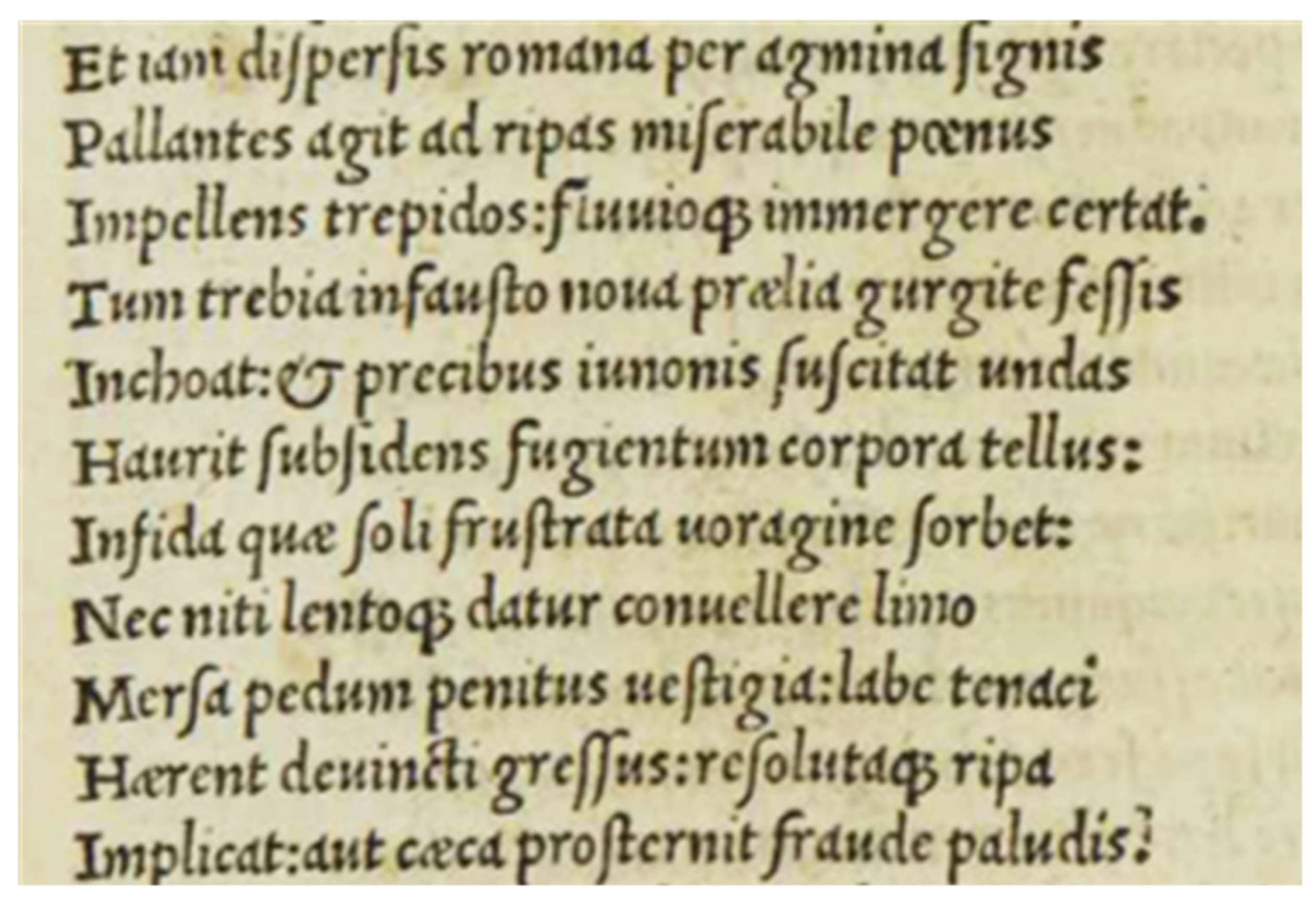
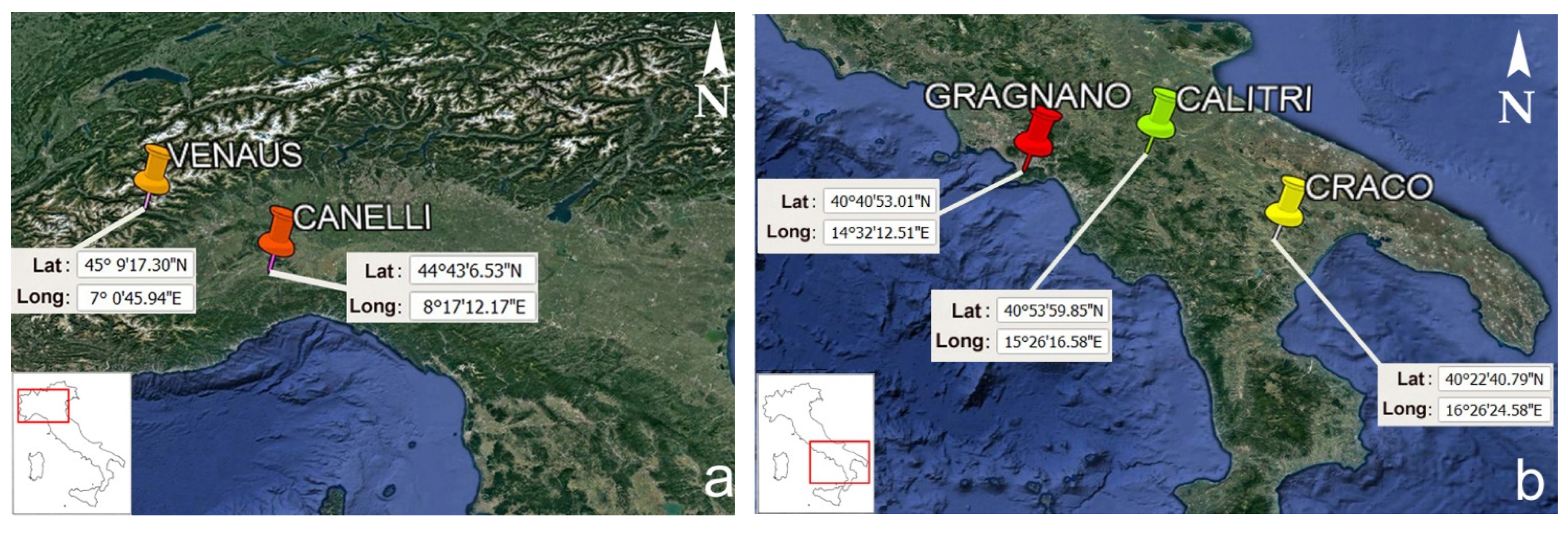
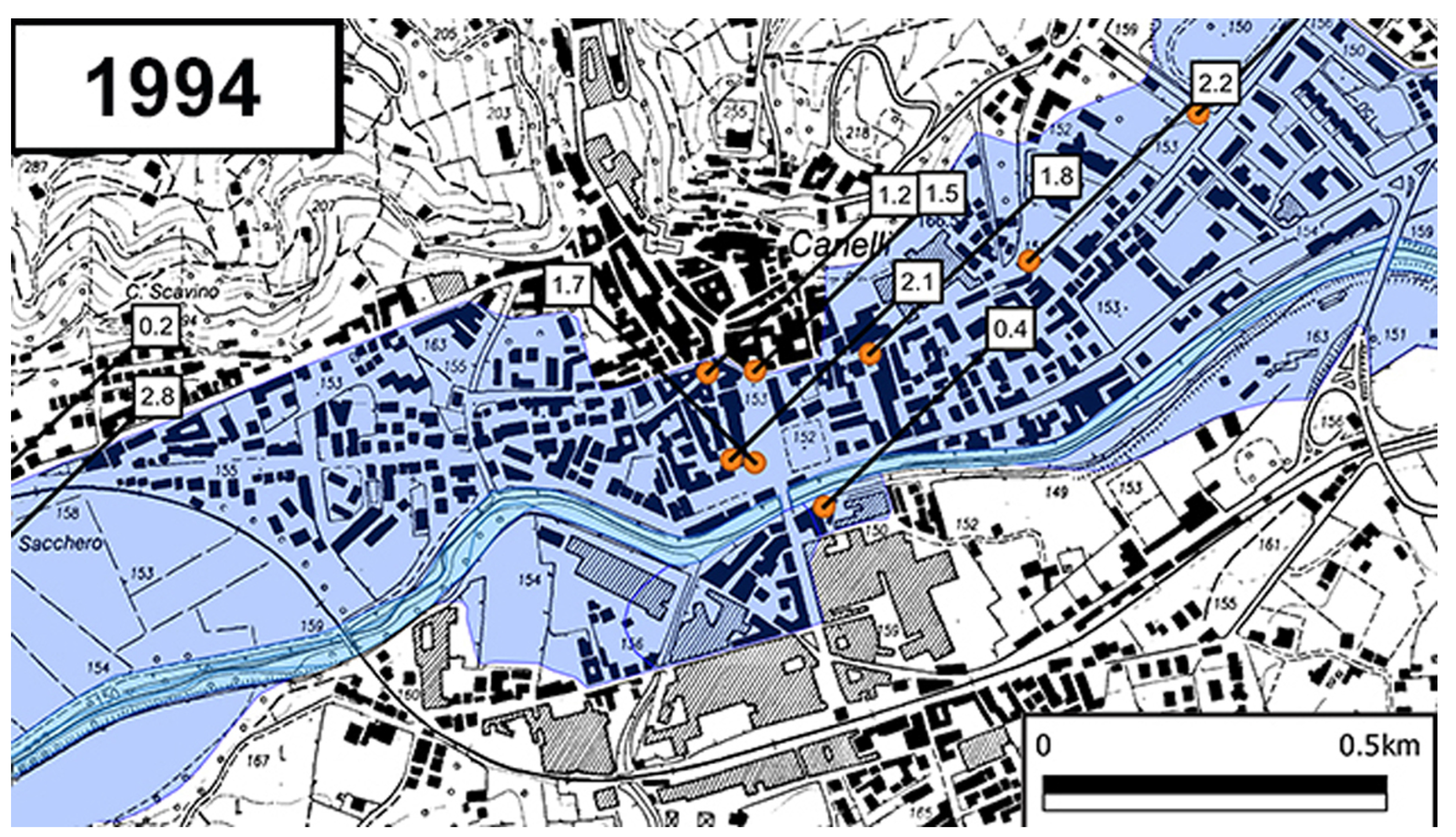
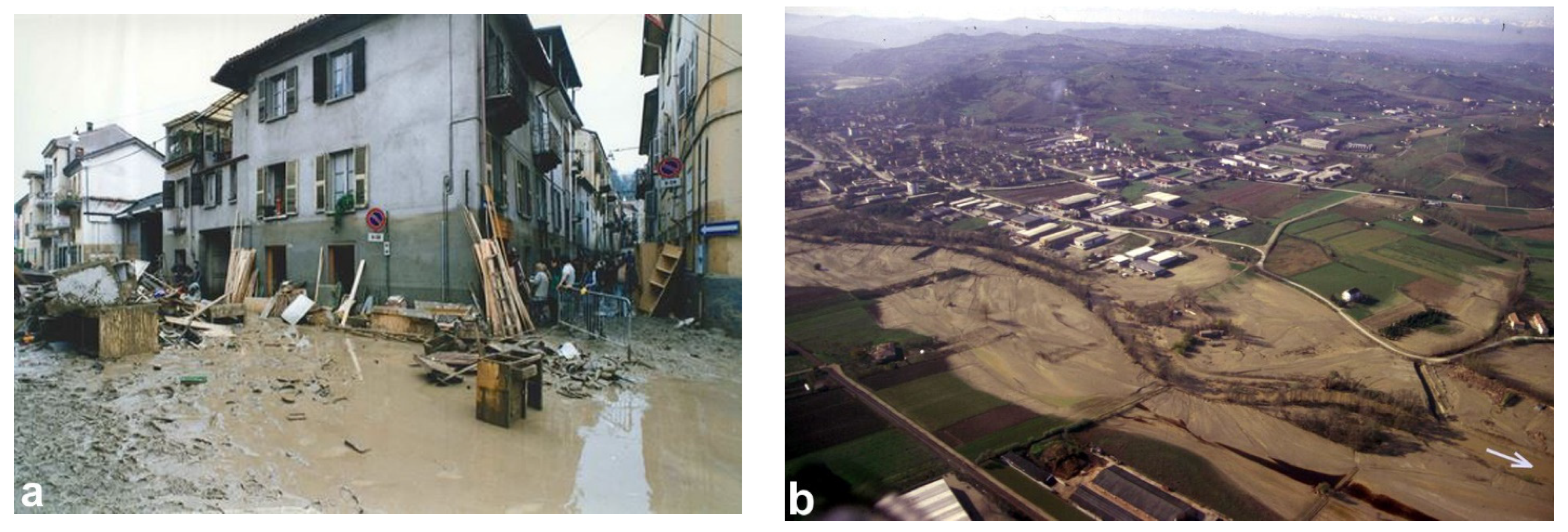
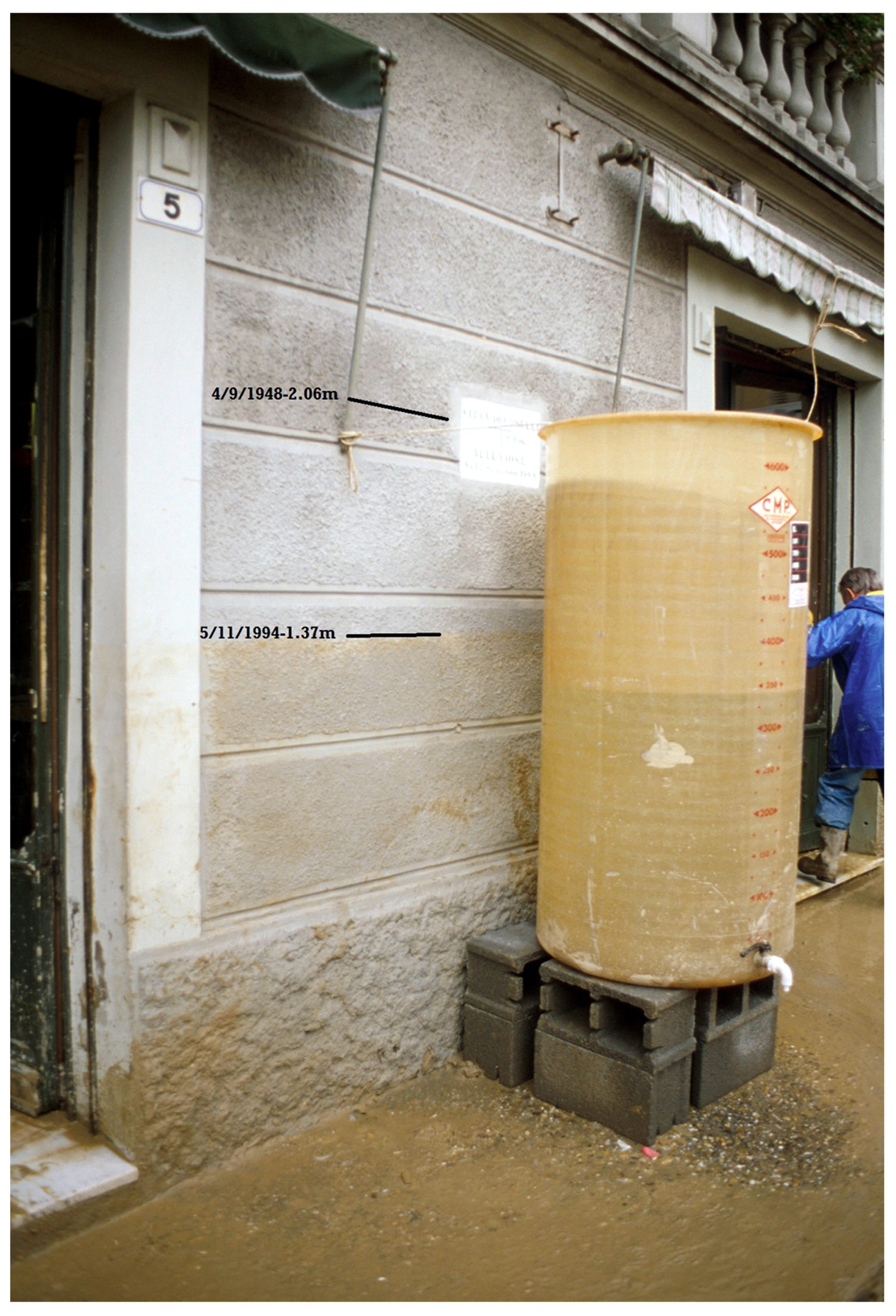
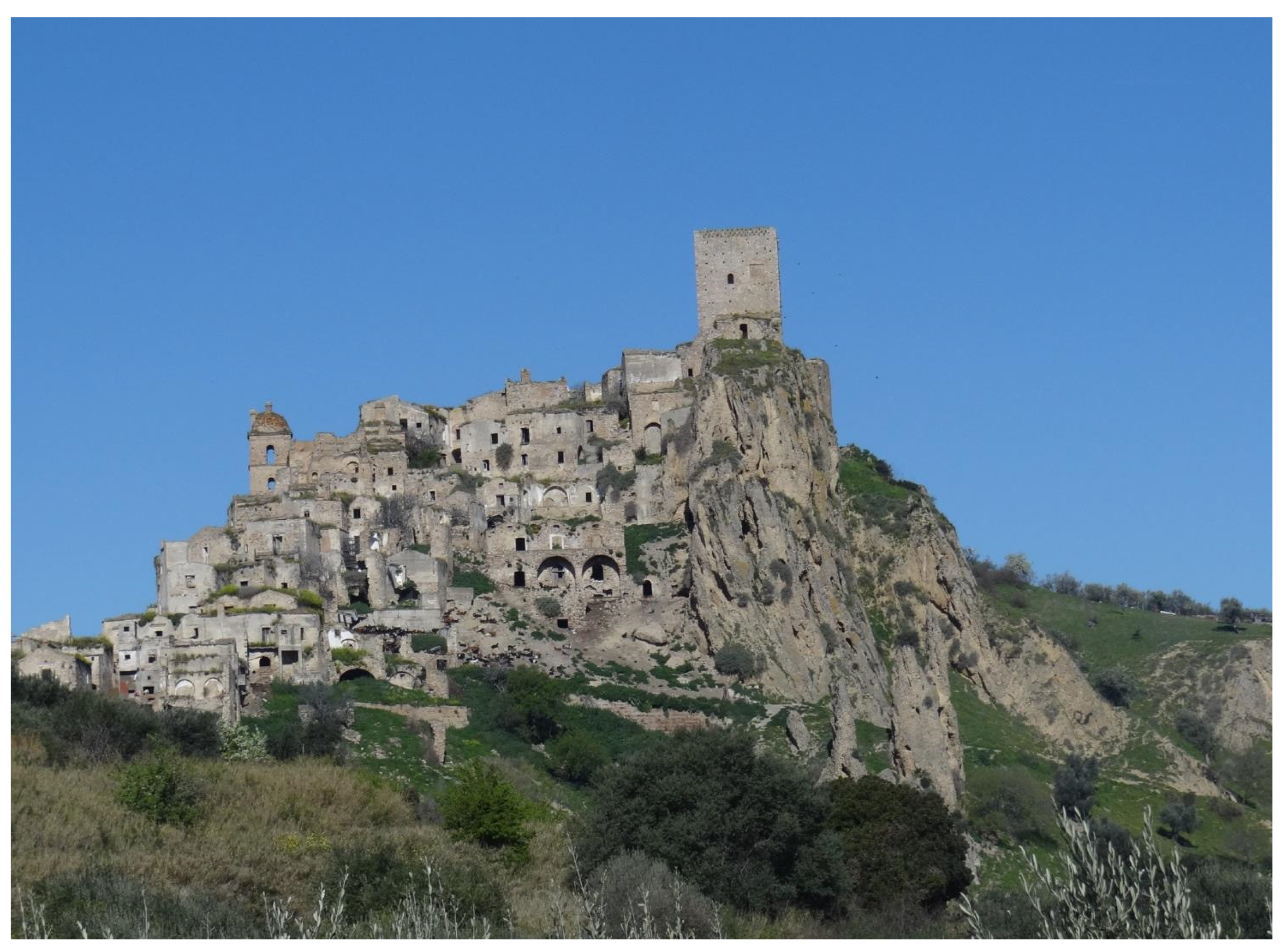
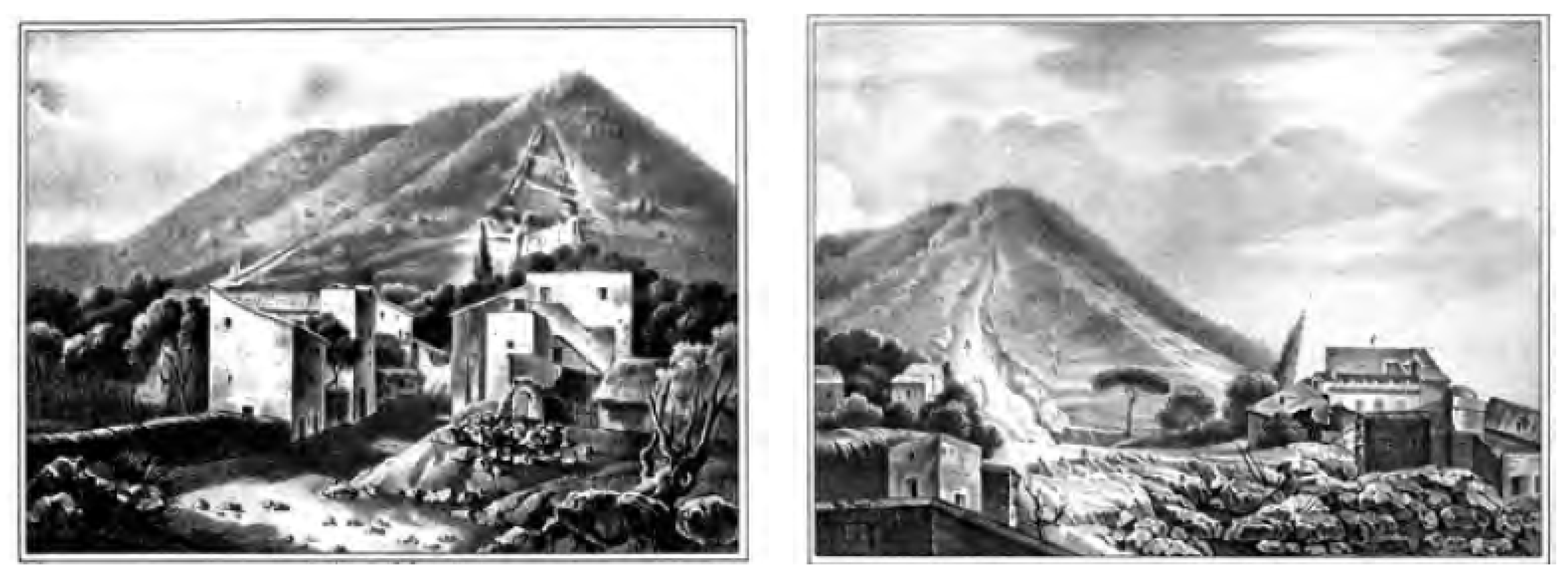
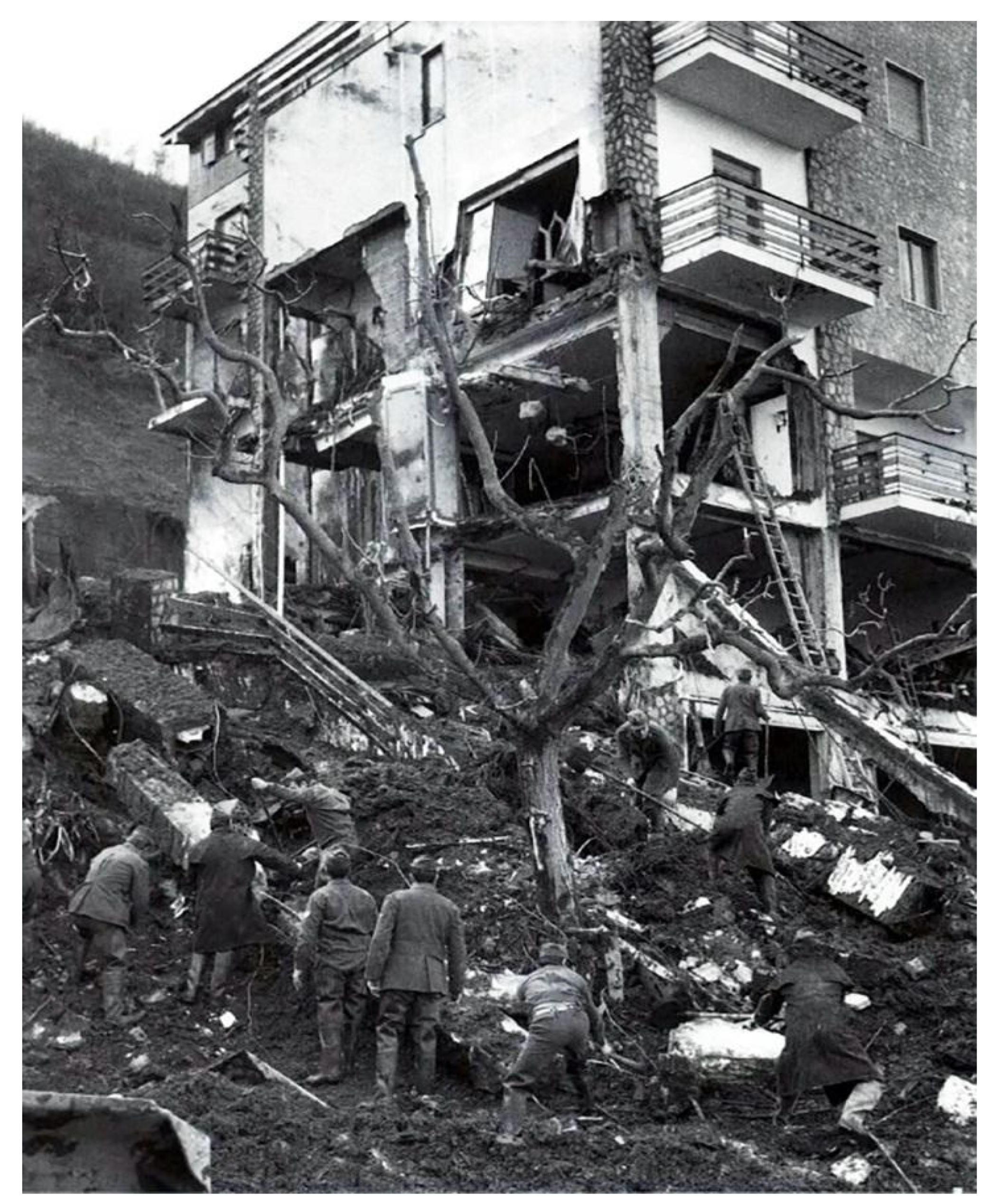


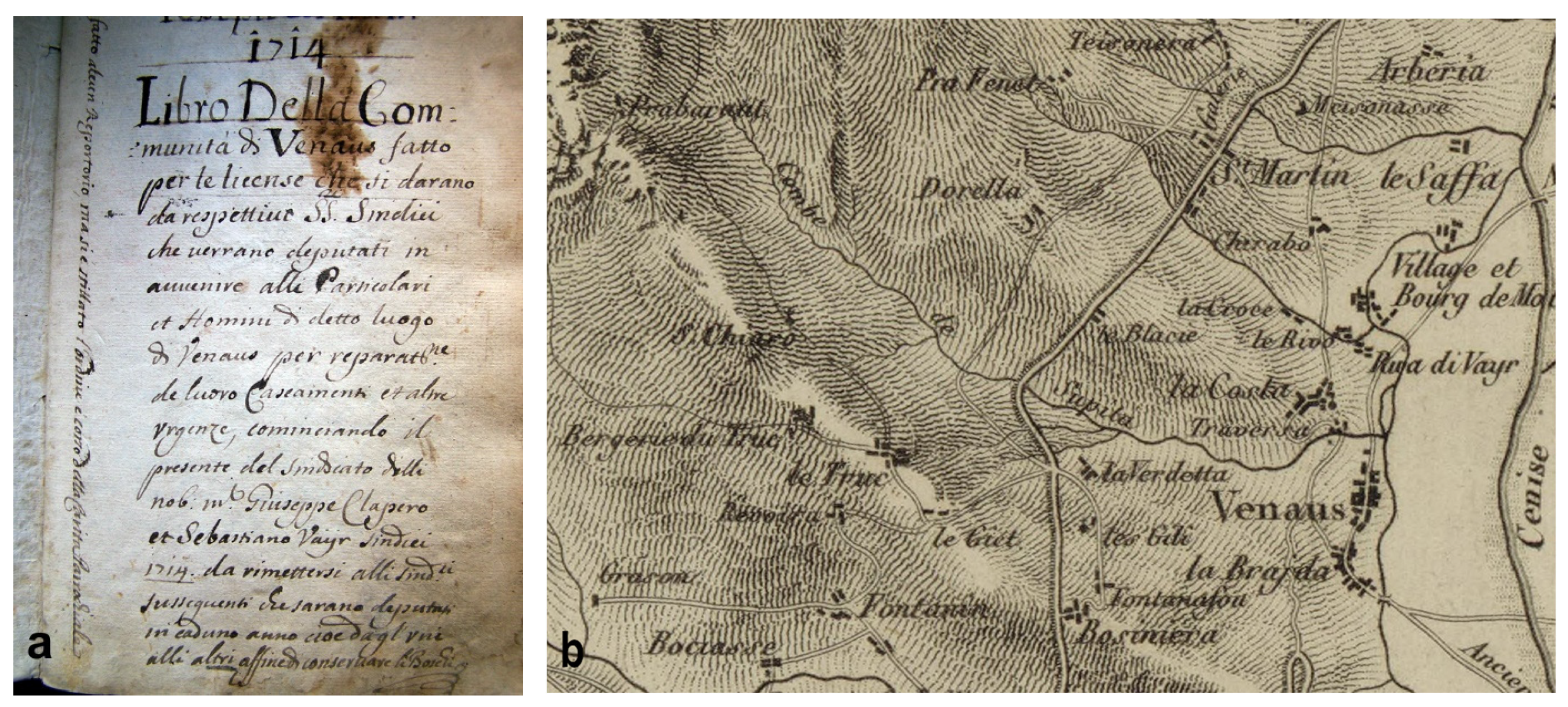
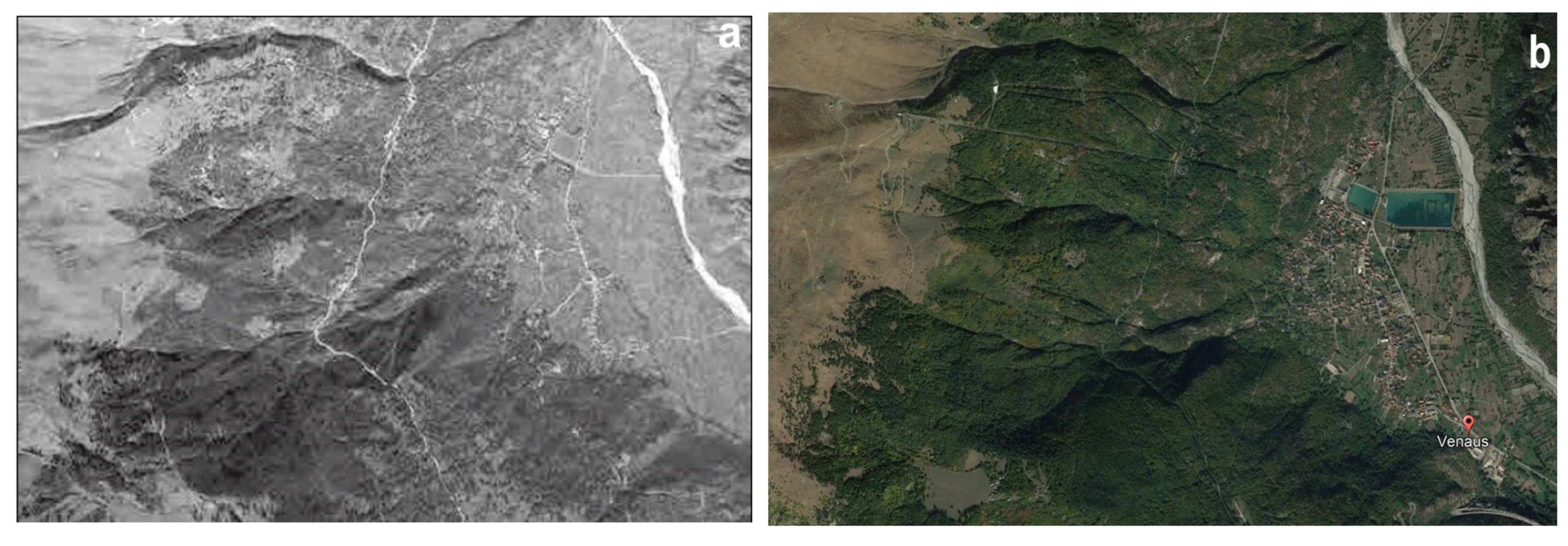
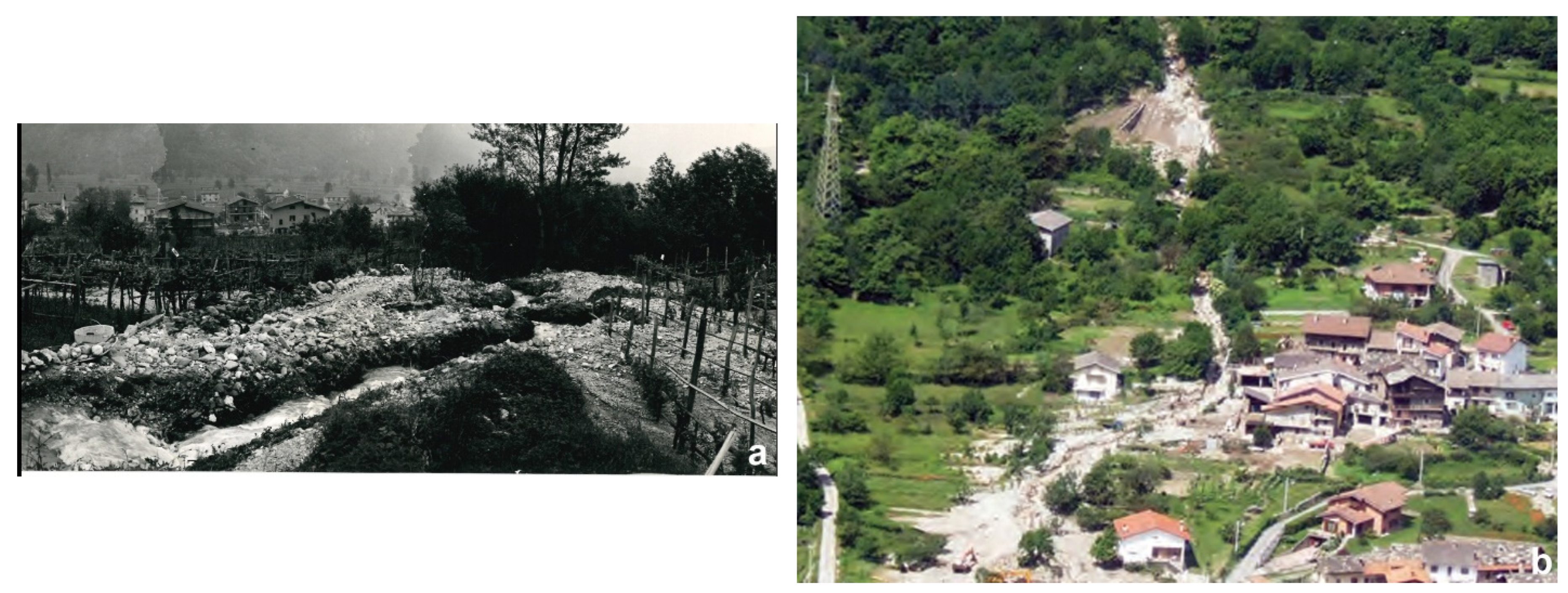

| Town/Village | Region | Province | Inhabitants (2021) |
|---|---|---|---|
| Venaus | Piedmont | Turin | 883 |
| Canelli | Piedmont | Asti | 10,165 |
| Gragnano | Campania | Naples | 28,293 |
| Calitri | Campania | Avellino | 4256 |
| Craco (old town) | Basilicata | Matera | 0 (abandoned) |
| Date | Event | Description | Source |
|---|---|---|---|
| 20–21 May 1728 | MDF | Due to heavy rain on 20 and 21 May, the Cenischia and Supita streams and others transported a large quantity of land and demolished most of the road and some houses, with loss of furniture | Atti delle visite di corrosione per la comunità di Venaus [200] |
| 25 May 1836 | MDF | Clearance of boulder that fell on Moncenisio road in Supita region | Historical Archive of Venaus Municipality |
| 15 January 1845 | A | Civil buildings buried, 6 casualties | ARPA Piemonte Archive |
| 18 January 1885 | A | Civil buildings damaged | ARPA Piemonte Archive |
| April 1904 | MDF | Mass transport along Supita stream, with damage to national road and Mont Cenis; flooded distant land | [205] |
| March 1930 | A | Wooded area damaged; avalanche arrived nearly uphill of Case Costa | ARPA Piemonte Archive |
| March 1934 | A | Avalanche dammed Moncenisio state road | ARPA Piemonte Archive |
| 13–14 June 1957 | TF | Torrential flood of Supita stream with intense solid contribution to fan, damage to crossing and defense works | [200] |
| 19 May 1977 | TF | Supita, powered by three landslides in late evening, partially flooded land in the fan and part of Venaus also due to the undersizing of bridge crossing river | [200] |
| 15 October 2000 | TF | Torrential flooding originated from the Supita stream; at a crossing, outflow surmounted a municipal road; phenomenon also involved a river crossing | [206] |
| 29 May 2008 | MDF | At around 7:00 am on 29 May, a significant process of mud–debris flow occurred; after totally obstructing the State Road 25 bridge in Moncenisio, the solid–liquid mixture invaded numerous buildings in the historical center; Supita stream deposit was not contained by retention basin recently built above | [191] |
| 13 April 2008 | A | Mass interrupted one road | ARPA Piemonte Archive |
| 15 December 2018 | A | Avalanche repeatedly hindered transit along main access road to Colle del Moncenisio, destroyed an extensive area of wood, and stopped in the canals about 200 m from some houses below | [195,207] |
Disclaimer/Publisher’s Note: The statements, opinions and data contained in all publications are solely those of the individual author(s) and contributor(s) and not of MDPI and/or the editor(s). MDPI and/or the editor(s) disclaim responsibility for any injury to people or property resulting from any ideas, methods, instructions or products referred to in the content. |
© 2023 by the authors. Licensee MDPI, Basel, Switzerland. This article is an open access article distributed under the terms and conditions of the Creative Commons Attribution (CC BY) license (https://creativecommons.org/licenses/by/4.0/).
Share and Cite
Luino, F.; Gizzi, F.T.; Palmieri, W.; Porfido, S.; Turconi, L. Historical Memory as an Effective and Useful Tool for Proper Land Use Planning: Lessons Learnt from Some Italian Cases. Land 2023, 12, 1751. https://doi.org/10.3390/land12091751
Luino F, Gizzi FT, Palmieri W, Porfido S, Turconi L. Historical Memory as an Effective and Useful Tool for Proper Land Use Planning: Lessons Learnt from Some Italian Cases. Land. 2023; 12(9):1751. https://doi.org/10.3390/land12091751
Chicago/Turabian StyleLuino, Fabio, Fabrizio Terenzio Gizzi, Walter Palmieri, Sabina Porfido, and Laura Turconi. 2023. "Historical Memory as an Effective and Useful Tool for Proper Land Use Planning: Lessons Learnt from Some Italian Cases" Land 12, no. 9: 1751. https://doi.org/10.3390/land12091751
APA StyleLuino, F., Gizzi, F. T., Palmieri, W., Porfido, S., & Turconi, L. (2023). Historical Memory as an Effective and Useful Tool for Proper Land Use Planning: Lessons Learnt from Some Italian Cases. Land, 12(9), 1751. https://doi.org/10.3390/land12091751










